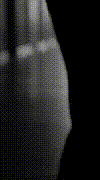QueenBeeBeeMari
Guest
- Joined
- Dec 30, 2006
- Messages
- 4,319
- Points
- 0
I cannot remember who brought this up first but I know somebody did. A person on this site brought up a story about a lady being tickled to insanity and you all wanted the story and asked where it was said on Wikipedia. Now I will give you the story but I want to first state the fact that I in no way believe this story from wikipedia but I will give it to you all for your reading pleasure.
First, 'Orrible Murder: An Anthology of Victorian Crime and Passion Compiled from the Illustrated Police News (by Leonard De Vries, published by Book Club Associates in London in 1974) (pp 73-4) reissued a news item first published in the Illustrated Police News on December 11, 1869: 'A Wife Driven Insane by Husband Tickling Her Feet.' The account states that Michael Puckridge had previously threatened the life of his wife, described as "an interesting looking young woman." Puckridge tricked his wife into allowing herself to be tied to a plank. Afterward, "Puckridge deliberately and persistently tickled the soles of her feet with a feather. For a long time he continued to operate upon his unhappy victim who was rendered frantic by the process. Eventually, she swooned, whereupon her husband released her. It soon became too manifest that the light of reason had fled. Mrs. Puckridge was taken to the workhouse where she was placed with the other insane inmates." (page 74) The husband was given away by Mrs. Puckridge's niece who was aware of the torture and spoke to neighbors about it. The article does not say if Puckridge confessed his crime to the niece after the deed was done, or if the niece actually watched the feather relentlessly scraping away at her aunt's soles, and ultimately, her sanity.
Second, a Sunday, September 6, 1903, special to the New York Times included a small item on its first page (page 1, no byline), "Treated Patient Brutally." At the Hudson River State Hospital, one suicidal patient, John Hayes, was immobilized on a bed for his own safety. While he lay helpless, the patient's woes were multiplied by one of the hospital attendants, Frank A Sanders. "Sanders is said to have confessed that while intoxicated he amused himself himself by tickling the feet and ribs of Hayes and pulling his nose." (page 1) Sander's also gave his restrained victim a black eye. Another hospital employee came upon Sanders while he was entertaining himself at his patient's expense, and the criminal was brought before a grand jury.
The third instance of documentation is found in David Ker's New York Times article, "England in Old Times" (page 11 of New York Times, November 13, 1887), where Ker writes, "Gone, too, are the parish stocks, in which offenders against public morality formerly sat imprisoned, with their legs held fast beneath a heavy wooden yoke, while sundry small but fiendish boys improved the occasion by deliberately pulling off their shoes and tickling the soles of their defenseless feet."
Additionally of interest, the April 14, 1872 New York Times article (page 11), "Terrible Punishments: The Russian Knout and Turkish Bastinado--How the Punishments are inflicted," the author (byline of L.G.C., no name is given, only initials) refers to foot tickling in an effort to explain the intense pain caused by the bastinado. "I have heard men cry out in agony . . . but I never heard such heart-rending sounds as those from the poor bastinadoed wretch before me," the author remarks. Three paragraphs later he writes "Such is the bastinado. And of the intenseness of the agony which its infliction produces, one has only to think of the congeries or plexus of delicate nerves which have their terminus in the feet. Even 'tickling the soles of the feet has often produced death; what then must be the excruciating pain when cruel violence is done to those most sensitive members?"
The woman who was driven mad by tickling and the man who was tickled after being restrained as a madman shared a tiny shred of luck amid their misfortunes. The ones who tickled them were caught. Since it is likely that a feather or finger persistently tickling a person is going to leave few marks or none at all, we owe the first two accounts above to the fact that witnesses spoke up for the unfortunates who had been thus tormented. Otherwise, Puckridge and Sanders might have gotten away scot free, and these accounts of tickle torture would have been lost to posterity.
also here is the link from which this article came:
http://en.wikipedia.org/wiki/Tickle_torture
First, 'Orrible Murder: An Anthology of Victorian Crime and Passion Compiled from the Illustrated Police News (by Leonard De Vries, published by Book Club Associates in London in 1974) (pp 73-4) reissued a news item first published in the Illustrated Police News on December 11, 1869: 'A Wife Driven Insane by Husband Tickling Her Feet.' The account states that Michael Puckridge had previously threatened the life of his wife, described as "an interesting looking young woman." Puckridge tricked his wife into allowing herself to be tied to a plank. Afterward, "Puckridge deliberately and persistently tickled the soles of her feet with a feather. For a long time he continued to operate upon his unhappy victim who was rendered frantic by the process. Eventually, she swooned, whereupon her husband released her. It soon became too manifest that the light of reason had fled. Mrs. Puckridge was taken to the workhouse where she was placed with the other insane inmates." (page 74) The husband was given away by Mrs. Puckridge's niece who was aware of the torture and spoke to neighbors about it. The article does not say if Puckridge confessed his crime to the niece after the deed was done, or if the niece actually watched the feather relentlessly scraping away at her aunt's soles, and ultimately, her sanity.
Second, a Sunday, September 6, 1903, special to the New York Times included a small item on its first page (page 1, no byline), "Treated Patient Brutally." At the Hudson River State Hospital, one suicidal patient, John Hayes, was immobilized on a bed for his own safety. While he lay helpless, the patient's woes were multiplied by one of the hospital attendants, Frank A Sanders. "Sanders is said to have confessed that while intoxicated he amused himself himself by tickling the feet and ribs of Hayes and pulling his nose." (page 1) Sander's also gave his restrained victim a black eye. Another hospital employee came upon Sanders while he was entertaining himself at his patient's expense, and the criminal was brought before a grand jury.
The third instance of documentation is found in David Ker's New York Times article, "England in Old Times" (page 11 of New York Times, November 13, 1887), where Ker writes, "Gone, too, are the parish stocks, in which offenders against public morality formerly sat imprisoned, with their legs held fast beneath a heavy wooden yoke, while sundry small but fiendish boys improved the occasion by deliberately pulling off their shoes and tickling the soles of their defenseless feet."
Additionally of interest, the April 14, 1872 New York Times article (page 11), "Terrible Punishments: The Russian Knout and Turkish Bastinado--How the Punishments are inflicted," the author (byline of L.G.C., no name is given, only initials) refers to foot tickling in an effort to explain the intense pain caused by the bastinado. "I have heard men cry out in agony . . . but I never heard such heart-rending sounds as those from the poor bastinadoed wretch before me," the author remarks. Three paragraphs later he writes "Such is the bastinado. And of the intenseness of the agony which its infliction produces, one has only to think of the congeries or plexus of delicate nerves which have their terminus in the feet. Even 'tickling the soles of the feet has often produced death; what then must be the excruciating pain when cruel violence is done to those most sensitive members?"
The woman who was driven mad by tickling and the man who was tickled after being restrained as a madman shared a tiny shred of luck amid their misfortunes. The ones who tickled them were caught. Since it is likely that a feather or finger persistently tickling a person is going to leave few marks or none at all, we owe the first two accounts above to the fact that witnesses spoke up for the unfortunates who had been thus tormented. Otherwise, Puckridge and Sanders might have gotten away scot free, and these accounts of tickle torture would have been lost to posterity.
also here is the link from which this article came:
http://en.wikipedia.org/wiki/Tickle_torture
Last edited:





